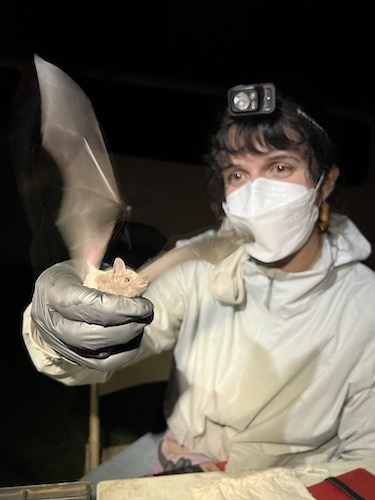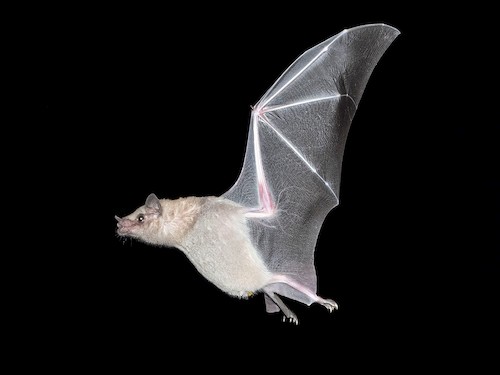 Mallory Davies with bat, courtesy of Mallory DaviesThe Gila Native Plant Society will resume its fall evening programs on Friday, October 20, 2023, at 7:00 pm, with a presentation entitled “Delinquent late-night pollinators: A story about nectar bats, agaves and what’s happening in the Gila,” by bat researcher Mallory Davies. The program will be presented live at Harlan Hall on the WNMU Campus in Room 111, as well as via Zoom for those who prefer to attend online. As always, the public is welcome. Anyone who prefers to join in online may request a Zoom link from gilanative@gmail.com .
Mallory Davies with bat, courtesy of Mallory DaviesThe Gila Native Plant Society will resume its fall evening programs on Friday, October 20, 2023, at 7:00 pm, with a presentation entitled “Delinquent late-night pollinators: A story about nectar bats, agaves and what’s happening in the Gila,” by bat researcher Mallory Davies. The program will be presented live at Harlan Hall on the WNMU Campus in Room 111, as well as via Zoom for those who prefer to attend online. As always, the public is welcome. Anyone who prefers to join in online may request a Zoom link from gilanative@gmail.com .
Have you been finding your hummingbird feeders drained overnight? Take in the GNPS program (in person or online) and find out more about the night-feeding nectar bats and why they matter. Our presenter, Mallory Davies, is a fourth-year PhD student in the Department of Fish, Wildlife, and Conservation Biology at Colorado State University and is associated with the Stoner Lab at the University of Arizona. Mallory is investigating how factors such as climate, agave nectar availability, and the availability of human-generated food sources such as sugar water from hummingbird feeders affect the movement and timing of nectar-feeding bats in southwestern New Mexico and southeastern Arizona. Mallory’s field team is based out of Hachita, NM, where they are studying New Mexico’s largest known lesser-long nosed bat roost site, located in the Big Hatchet Mountains. Mallory has since expanded her research into residential areas, including Silver City.
 lesser long-nosed bat, courtesy of Elroy LimmerMallory gives a preview of her talk: “The shape, color, and timing of nectar release of agave flowers indicates a co-evolution and mutualistic relationship with the nectar bats that pollinate it. Agave nectar is thought to be the only known plant food source for nectar bats in New Mexico. However, nectar bats are found visiting hummingbird feeders in Silver City late into the fall, months after Agave parryi (the dominant species of agave in the area) has finished flowering. To address this timing mismatch, my research focuses on the motivations of movement into New Mexico of the three nectar bats that persist in the United States, the lesser long-nosed bat (Leptonycteris yerbabuenae), the Mexican long-nosed bat (Leptonycteris nivalis), and the Mexican long-tongued bat (Choeronycteris mexicana). I will discuss the theory behind the mutualistic relationship and co-evolution of nectar bats and agave, current research happening in the area, preliminary findings, and how you can get involved.”
lesser long-nosed bat, courtesy of Elroy LimmerMallory gives a preview of her talk: “The shape, color, and timing of nectar release of agave flowers indicates a co-evolution and mutualistic relationship with the nectar bats that pollinate it. Agave nectar is thought to be the only known plant food source for nectar bats in New Mexico. However, nectar bats are found visiting hummingbird feeders in Silver City late into the fall, months after Agave parryi (the dominant species of agave in the area) has finished flowering. To address this timing mismatch, my research focuses on the motivations of movement into New Mexico of the three nectar bats that persist in the United States, the lesser long-nosed bat (Leptonycteris yerbabuenae), the Mexican long-nosed bat (Leptonycteris nivalis), and the Mexican long-tongued bat (Choeronycteris mexicana). I will discuss the theory behind the mutualistic relationship and co-evolution of nectar bats and agave, current research happening in the area, preliminary findings, and how you can get involved.”
The Gila Native Plant Society is committed to promoting education, research and appreciation of the native flora of the Southwest; encouraging the preservation of rare and endangered plant species; and supporting the use of suitable native plants in landscaping to create habitat and conserve water. For information on programs, publications and membership, please visit www.gilanps.org .